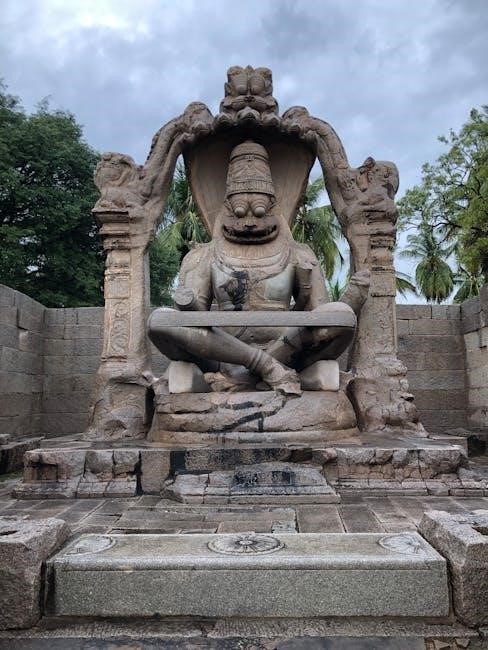Vishnu Sahasranama is a revered Sanskrit hymn containing 1,000 names of Lord Vishnu, symbolizing His divine attributes and universal supremacy. This sacred text, deeply rooted in Hindu scripture, is a cornerstone of Vaishnavism, offering spiritual enlightenment and devotion. Its significance extends beyond religious worship, serving as a cultural and educational treasure, recited daily by millions for its profound spiritual and philosophical insights.
1.1. Overview of Vishnu Sahasranama
Vishnu Sahasranama, a sacred Sanskrit hymn, consists of 1,000 names of Lord Vishnu, each highlighting His divine attributes and universal supremacy. Originating from the Mahabharata, it is a cornerstone of Vaishnavism, glorifying Vishnu as the ultimate reality. The text is structured as a dialogue between Bhishma and Yudhishthira, emphasizing its philosophical and spiritual depth. It is not just a devotional text but also a cultural and educational treasure, offering insights into Hindu theology. Recited daily by millions, it is believed to bring spiritual enlightenment, peace, and prosperity. Its verses are often chanted in temples and homes, making it a vital part of Hindu worship and tradition.
1.2. Importance of the Sanskrit Version
The Sanskrit version of Vishnu Sahasranama holds immense significance as it preserves the original divine intent and linguistic precision. Sanskrit, being the language of ancient Indian scriptures, ensures the authenticity and spiritual potency of the text. The intricate meanings and vibrations of the names are best captured in Sanskrit, making it indispensable for ritualistic recitation and meditation. The Sanskrit version is considered authoritative, maintaining the integrity of Vedic knowledge and tradition. Its universal appeal lies in its timeless relevance, transcending linguistic and cultural barriers. For scholars and devotees alike, the Sanskrit text remains a vital source for understanding the philosophical depth of Vishnu Sahasranama, ensuring its continued reverence and study across generations.

Historical and Cultural Significance
Vishnu Sahasranama, rooted in the Mahabharata, has been revered for centuries as a sacred hymn. It embodies spiritual significance, cultural heritage, and devotion, reflecting India’s rich philosophical traditions.
2.1. Origin and Background
Vishnu Sahasranama originates from the Mahabharata, specifically the Anushasana Parva. It is a dialogue between Bhishma and Yudhishthira, where Bhishma extols the virtues of Vishnu. The text comprises 1000 names of Vishnu, each signifying His divine attributes. This sacred hymn is considered a quintessential expression of devotion to Vishnu, embodying spiritual wisdom and philosophical depth. Its origins trace back to ancient India, reflecting the cultural and religious ethos of the time. The Sanskrit version is particularly revered for its authenticity and poetic beauty, making it a cornerstone of Hindu scripture and worship.
2.2. Role in Hindu Scripture and Worship
Vishnu Sahasranama holds a central place in Hindu scripture and worship, particularly within Vaishnavism. It is often recited during pujas, homas, and daily prayers, serving as a powerful medium for devotion and spiritual growth. The text is considered equivalent to the Vedas in its sacredness and is believed to bestow peace, prosperity, and liberation. Its recitation is a common practice in temples and homes, fostering a deep connection with the divine. Additionally, it is integrated into various rituals and ceremonies, enhancing its cultural and religious significance. The Sanskrit version is especially valued in worship due to its poetic precision and spiritual potency, making it a cornerstone of Hindu devotional practices.

Structure of the Text
Vishnu Sahasranama consists of 108 names, systematically arranged in the Anushtubh meter. It begins with “Om Vishnave Namah” and concludes with “Svaha,” creating a divine rhythmic flow.
3.1. Number of Verses and Names
The Vishnu Sahasranama consists of 108 verses, each containing a sacred name of Lord Vishnu. These verses are systematically arranged in the Anushtubh meter, a common poetic meter in ancient Indian literature. The text is part of the Mahabharata, specifically within the Anushasana Parva, and is revered for its rhythmic and spiritual significance. Each name in the Sahasranama carries profound meaning, reflecting Vishnu’s divine attributes, powers, and roles. The 108 names are considered complete and auspicious, symbolizing the totality of existence. This structured format makes it easy to recite and remember, ensuring its enduring popularity in Hindu devotion and scripture.
3.2. Sanskrit Language and Script
The Vishnu Sahasranama is composed in the ancient Sanskrit language, which holds a revered status in Hinduism for its spiritual purity and linguistic precision. The text is traditionally written in the Devanagari script, known for its clarity and aesthetic appeal. Sanskrit’s phonetic accuracy ensures that the recitation of the names retains their sacred essence. The script’s intricate design aligns with the rhythmic nature of Vedic chants, enhancing the devotional experience. Modern Sanskrit PDF versions maintain this traditional script, preserving the text’s authenticity and cultural heritage. The language and script together create a timeless connection to India’s spiritual legacy, making the Vishnu Sahasranama a cherished text for both devotion and scholarly study.

Sanskrit PDF Versions Available Online
Multiple websites offer Vishnu Sahasranama in Sanskrit PDF format, providing easy access for devotees and scholars. Religious portals and educational platforms ensure wide online availability.
4.1. Popular PDF Downloads
Several popular websites offer Vishnu Sahasranama in Sanskrit PDF format, catering to devotees and scholars worldwide. These downloads are often sourced from trusted platforms, ensuring authenticity and clarity. Many religious and cultural websites provide free access to these PDFs, while some include additional features like transliteration, translation, and commentary. Popular sources include temple websites, religious portals, and educational platforms. These PDFs are widely downloaded due to their readability, accurate Sanskrit text, and ease of access. They are ideal for both daily recitation and in-depth study, making them a valuable resource for spiritual seekers. Their availability online has made it easier for global audiences to connect with this sacred text.
4.2. Sources for Authentic Sanskrit Text
Authentic sources for Vishnu Sahasranama in Sanskrit PDF include reputable websites like the Vedic Heritage Portal, Sanskrit Library, and official temple websites. These platforms ensure the text adheres to traditional Vedic standards. Additionally, institutions such as the Adyar Library and Research Centre offer verified versions. Religious organizations like the Ramakrishna Mission and ISKCON also provide downloadable PDFs with accurate Sanskrit script. These sources are trusted for their meticulous preservation of the original text, ensuring users receive a genuine and culturally accurate version of Vishnu Sahasranama. They are widely recommended for scholars and devotees seeking reliable resources for study and recitation.
Key Features of the Sanskrit PDF
The Sanskrit PDF of Vishnu Sahasranama offers clear fonts, accurate script, and traditional formatting. It often includes transliterated versions, commentaries, and bookmarks for easy navigation.

5.1. Layout and Readability
The layout of the Sanskrit PDF is designed for optimal readability, with clear Devanagari script and proper spacing between verses. The text is typically presented in a clean, traditional format, preserving the authenticity of the original composition. Many versions include diacritical marks to aid in accurate pronunciation. The PDFs often feature consistent formatting, with each name and verse numbered for easy reference. Some editions incorporate annotations or footnotes to explain complex terms or provide context. The overall design ensures that the sacred text remains accessible and visually appealing, making it suitable for both casual reading and scholarly study.
5.2. Additional Resources and Commentaries
Many Sanskrit PDF versions of the Vishnu Sahasranama include additional resources and commentaries to enhance understanding. These may feature explanations of each name, providing deeper insights into their spiritual significance. Some editions incorporate translations in English or other languages, making the text accessible to a broader audience. Additionally, scholarly commentaries and footnotes are often included, offering historical context and philosophical interpretations. Certain PDFs also include devotionals, prayers, or introductory essays that highlight the cultural and religious importance of the text. These supplementary materials make the PDF a comprehensive tool for both spiritual practice and academic study, enriching the reader’s experience.

Benefits of Reading Vishnu Sahasranama
Reading Vishnu Sahasranama fosters spiritual growth, mental peace, and divine connection. It enhances devotion, promotes emotional balance, and offers solace in challenging times.
6.1. Spiritual and Religious Significance
The Vishnu Sahasranama holds profound spiritual and religious significance, offering devotees a deep connection to the divine. Reciting the Sanskrit PDF version is believed to purify the soul, bestow blessings, and grant wisdom. It is considered a powerful tool for spiritual growth, fostering devotion and mindfulness. Many followers recite it during prayers, ceremonies, and personal worship to seek divine grace. The text’s sacred verses are thought to alleviate suffering, promote inner peace, and strengthen one’s faith in the divine. Regular recitation is also believed to enhance spiritual awareness and bring the devotee closer to achieving liberation. Its significance is deeply rooted in Hindu tradition and remains a vital part of spiritual practices.
6.2. Cultural and Educational Value
The Vishnu Sahasranama Sanskrit PDF holds significant cultural and educational value, preserving ancient Indian heritage and linguistic traditions. It serves as a vital resource for understanding classical Sanskrit, offering insights into India’s rich philosophical and literary history. Scholars and students alike use it to study the structure of Sanskrit poetry and the depth of Vedic thought. The text also fosters cultural appreciation, promoting the importance of preserving sacred scriptures. Its educational value lies in its ability to teach language, history, and spirituality, making it a cherished text for both academic and cultural enrichment. It remains a cornerstone of India’s intellectual and cultural legacy.

How to Use the Sanskrit PDF
Download and install a PDF reader with Sanskrit font support. Create a quiet, reverent space for study or recitation. Use the text for daily meditation or worship, and reference commentaries for deeper understanding. Regular practice enhances spiritual connection and knowledge retention. Ensure proper pronunciation by following guidelines or seeking guidance from scholars. This sacred text is a powerful tool for personal growth and devotion.
7.1. Guidelines for Recitation

Begin with purification rituals like Achamanam to cleanse the mind and body. Wear clean, simple clothing and sit in a quiet, sacred space. Recite with focus and devotion, pronouncing each Sanskrit name accurately. Seek guidance from a guru or learned scholar for proper intonation. Avoid distractions and maintain concentration. Recitation is ideal during early morning or evening hours; Chanting with a group enhances spiritual energy. Pause briefly after each verse for reflection. Use the PDF as a guide, ensuring correct pronunciation and rhythm. Regular practice fosters a deeper connection to Lord Vishnu and spiritual growth.
7.2. Tips for Effective Study
For effective study of the Vishnu Sahasranama Sanskrit PDF, begin by understanding the Sanskrit language basics. Use commentaries or translations to grasp the deeper meanings of each name. Break the text into smaller sections, focusing on a few verses at a time. Engage in group discussions or join study circles to enhance comprehension. Maintain consistency by dedicating a specific time daily for study. Reflect on the spiritual and philosophical significance of each name. Keep a study journal to note insights and questions. Respect the cultural and religious context of the text. Lastly, seek guidance from scholars or authentic sources to avoid misinterpretations and ensure a meaningful learning experience.
Common Mistakes to Avoid
Common mistakes include mispronouncing Sanskrit names, ignoring context, and skipping foundational knowledge. Avoid rushed recitation and disregard for cultural significance. Use authentic sources and seek guidance to prevent errors;
8.1. Pronunciation and Interpretation Errors
Pronunciation and interpretation errors are common when reciting the Vishnu Sahasranama in Sanskrit. Mispronouncing syllables can alter meanings, leading to spiritual misalignment. Many mistake long and short vowels, ignoring stress patterns. Additionally, interpreting names without context can cause misunderstandings. For instance, names like “Bhūta-bhavya-bhavanātha” are often misread due to complex syllables. Misinterpreting compound words or ignoring sandhi rules further complicates understanding. Such errors can diminish the spiritual impact and distort the hymn’s essence. Proper tutoring and practice are essential to avoid these pitfalls. Reciting slowly and focusing on accurate intonation ensures authenticity and preserves the sacred text’s integrity.
8.2. Misunderstandings of Names and Meanings
Misunderstandings of the names and meanings in the Vishnu Sahasranama often arise due to the complexity of Sanskrit and its nuanced interpretations. Many names are symbolic, representing divine attributes rather than literal descriptions. For example, names like “Adhokshaja” (beyond sensory perception) are often misinterpreted without proper context. Cultural and historical insights are crucial for accurate comprehension. Additionally, some names are compound words, and breaking them down incorrectly can lead to wrong meanings. Misunderstandings can also stem from ignoring the spiritual connotations of the text. To avoid these errors, it is essential to study the hymn with authentic commentaries and guidance from scholars, ensuring the deeper significance of each name is preserved and understood correctly.

Vishnu Sahasranama is a revered hymn embodying divine reverence and spiritual growth. Its timeless appeal continues to inspire devotion, offering a profound connection to the divine essence.
9.1. Final Thoughts on Vishnu Sahasranama

Vishnu Sahasranama is a divine hymn that encapsulates the essence of devotion and spiritual enlightenment. The Sanskrit PDF version serves as a valuable resource for worship and study, preserving its timeless significance. It provides a clear and accessible format for recitation, enabling devotees to connect deeply with the divine. Regular chanting is believed to bring peace, prosperity, and spiritual growth. The PDF’s authenticity ensures the purity of the text, making it a reliable tool for those seeking to understand its profound meaning. Emphasizing correct pronunciation and interpretation is crucial for maximizing its benefits. By embracing this sacred text, one can experience its transformative power in their spiritual journey.
